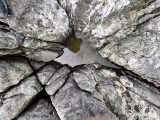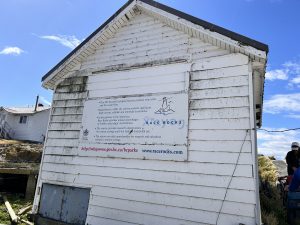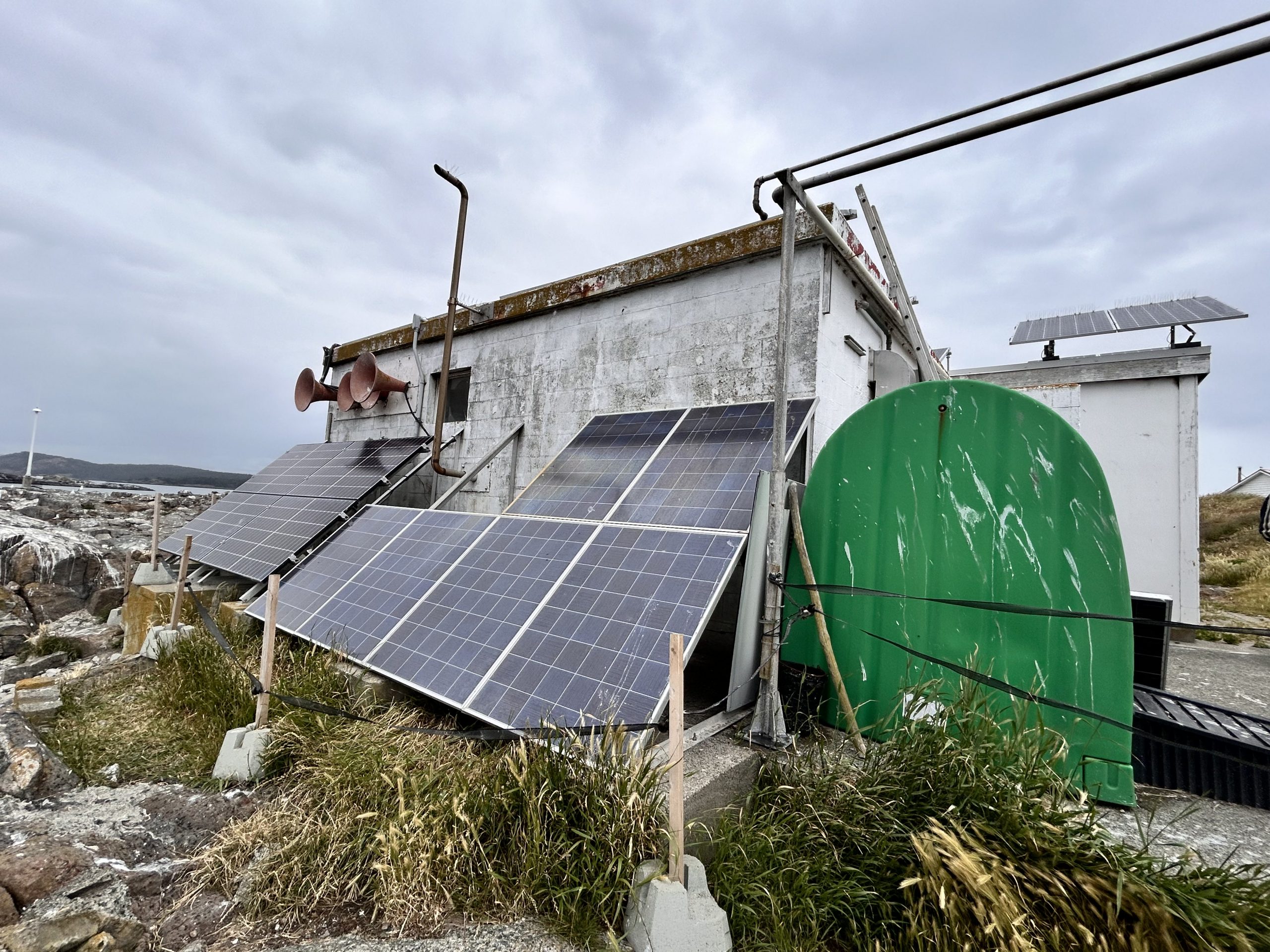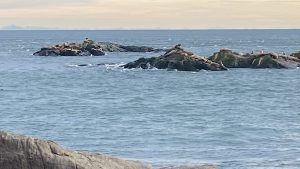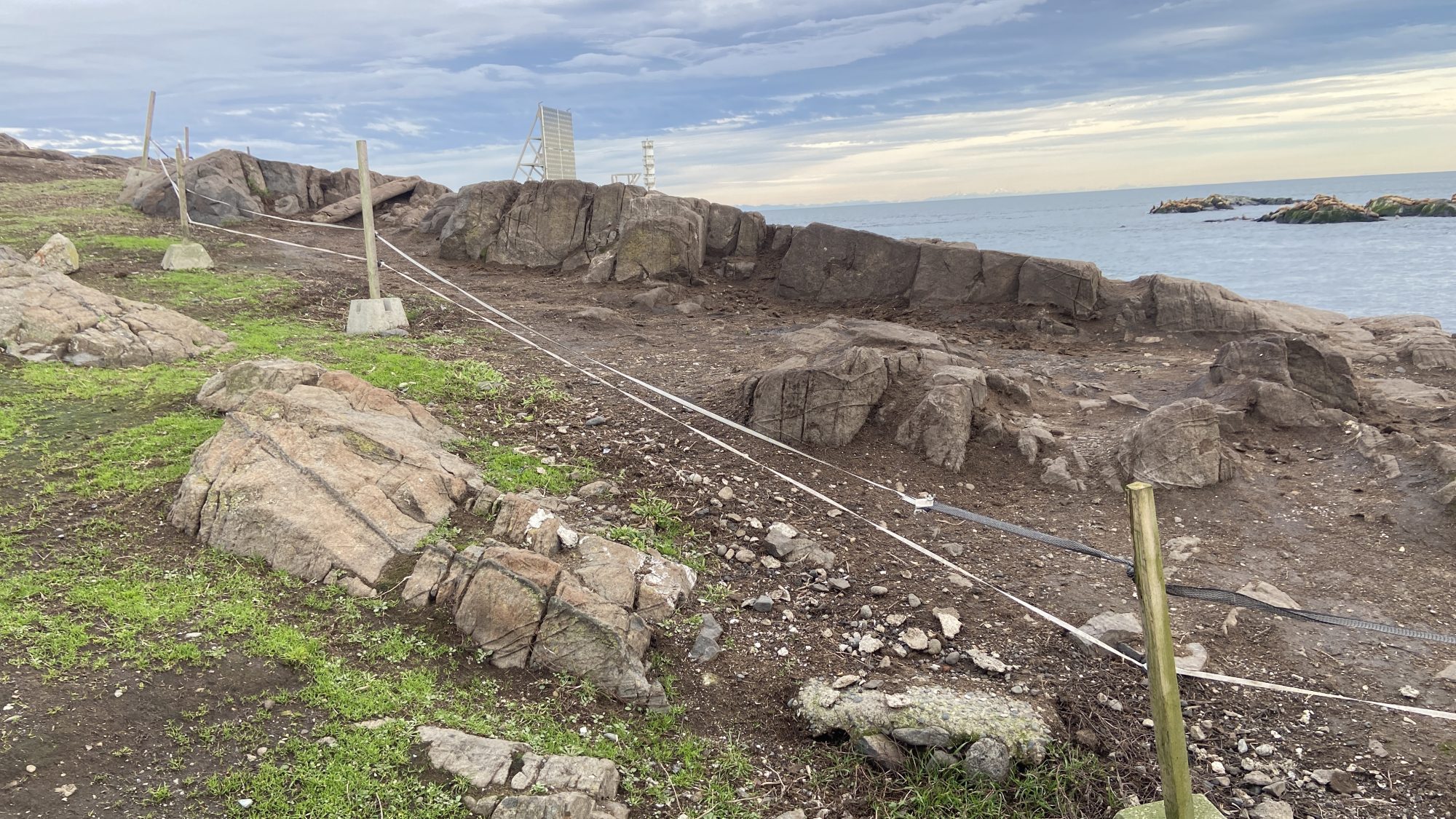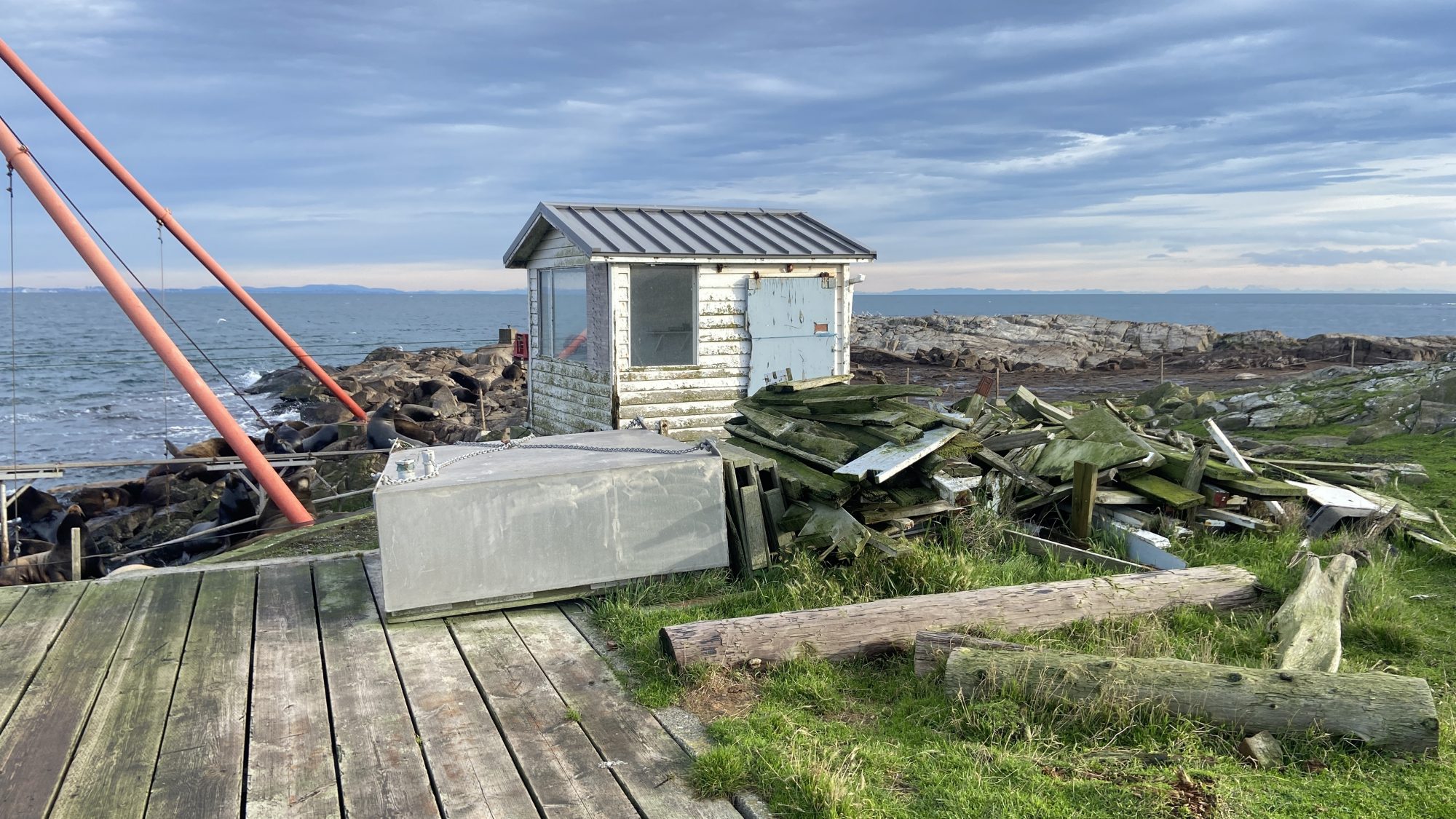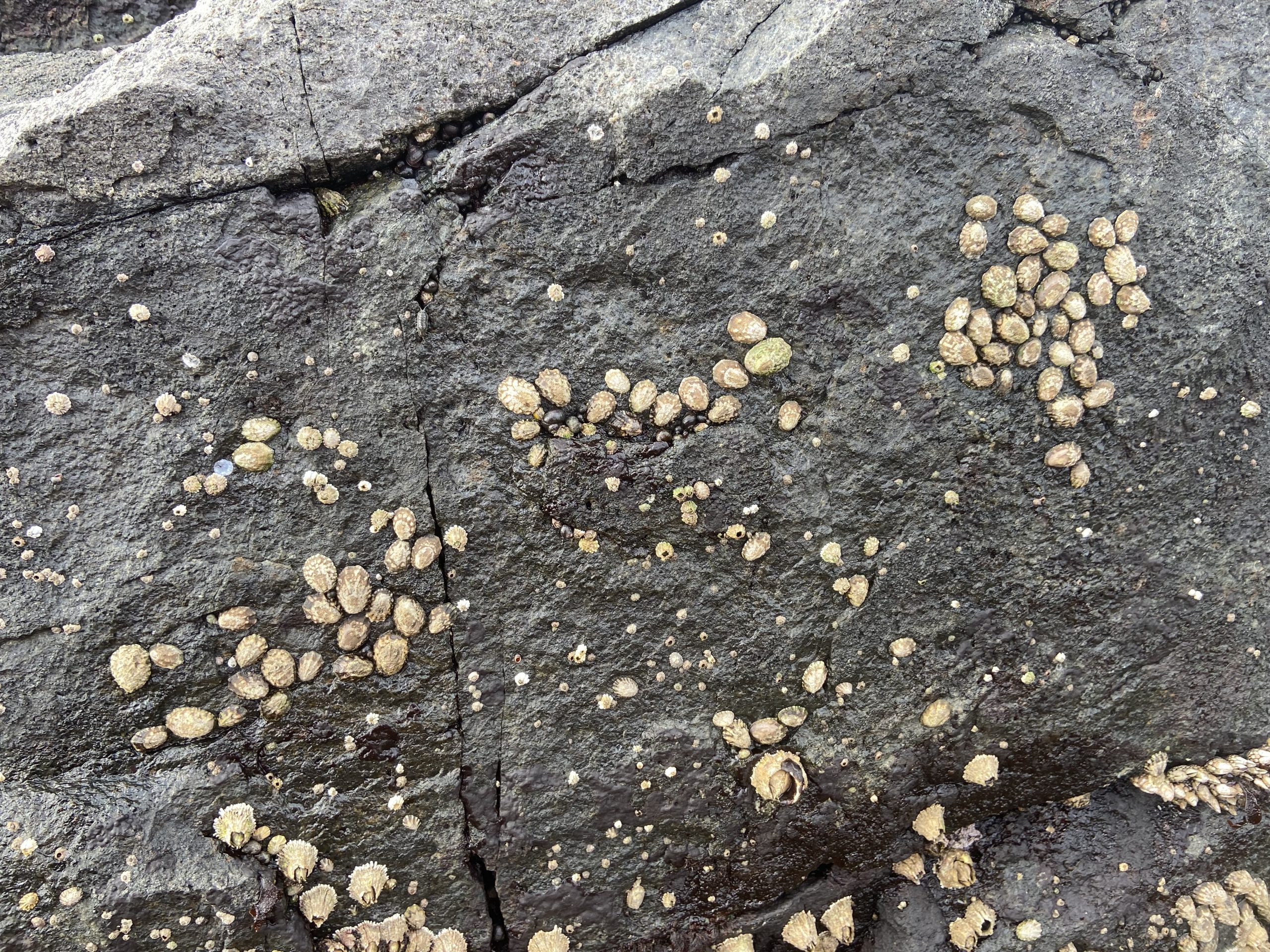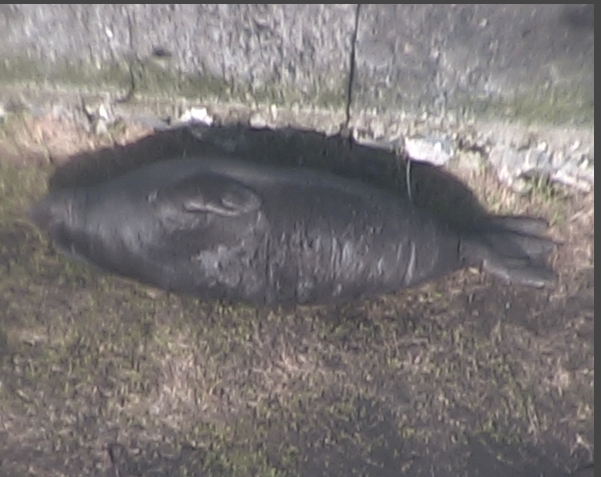The following article from the Victoria Times Colonist with a video of an interview with Dr. Martin Haulena of the Vancouver Aquarium appeared in the Times Colonist on October 29 2024 concerning the rescue of an entangled sea lion at Race Rocks Ecological Reserve:
Category Archives: Archived Video
Race Rocks Ecological Reserve Warden’s Report June 14 2024
Garry Fletcher, ER Warden for Race Rocks visited the reserve on June 14, 2024
 Greg Dickinson from Pearson College provided transport in Second Nature for the following group:
Greg Dickinson from Pearson College provided transport in Second Nature for the following group:
- Lisette and Mads – Mads is a former student and both are volunteering at Pearson College
- Garry Fletcher – Park Warden
- James Tuohy – future Ecoguardian
- Ann Nightingale and Andrew Jacobs – Rocky Point Bird Observatory
Upon docking I was struck by the number of Pigeon Guillemots on the rocks . Although I haven’t checked back in our records, there certainly seems to have been an increase in numbers
We were greeted by the new ecoguardian Christine Chourmouzis . In addition to having a general survey of the reserve, I was able to direct Christine and James through the process of entering them as editors on racerocks.ca and creating a log and posting it on the Race Rocks website.
 Supplies for the Ecoguardian are off-loaded
Supplies for the Ecoguardian are off-loaded
- Sea lion fence
- For several years now we have mainytained a sealion fence to keep the sealions out of the central island area where they can cause damage to infrastructure . This year, I submitted an application to BC Parks for funding to pay for installation of a permanent fenceline as the temporary posts are often pushed over by the sealions when they accumulate in the fall in massive numbers on the archipelago of islands
- This year there has been an invasion of the grass foxtail over much of the island
- It has almost totally replaced the pineapple weed which has been abundant in previous years
- one of the many Ecotourism boats passes through the channel North of the docks
- James and Ann documented nests and locations on the island
- Most nests have some eggs
- The Glaucous-winged gull
- Glaucous winged and the western xglaucous -winged hybrid
- a barn swallows nest has appeared although there were no birds in sight
- A lone cormorant on the south side of great Race Island
- Ann Nightingale came out to do a proper survey of the Gull population with Andrew Jacobs of the Rocky Point Bird Observatory
- Various invasive polants grow in the compost bin
When I was teaching at Pearson College, we often monitored a set of tidepools out on the island’s West side. I checked out those pools again and took photos which show the state of algae growth. Some observations in the tidepool files provide a baseline for comparative studies in the future. These files are on the tidepools
Today’s observations are in the set of photos below
- Tidelpool#1
- tidelpool#2
- tidelpool#3
- tidelpool#4
- tidelpool#5
- tidelpool#6
- tidepool#7
- tidepool8
- tidelpool#9
- tidelpool#10
 I checked pool #4 which has a white quartz intrusion through it to see if the white periwinkle snails were still there.
I checked pool #4 which has a white quartz intrusion through it to see if the white periwinkle snails were still there.
A review of some of the installations on the Island
- Always a problem is the growth of Algae on the buildings. The Ecoguardians play a big role in trying to keep up with this problem and it involves scrubbing and hosing down.
- The latest version of composting toilet has proven to be very effective.
- Newly added Solar panels provide effective production of energy to run the island in the summer months I hope we can get the red goghorn bells repainted soon . They were te last air chime s to be in service in North America
- I checked on the Davis weather instrument as there have been some erroneous readings of the rain guage tis spring. All seemed to be functioning normally at this end.
- Greg gives instruction on the runneiing of equipment in the engine room to James.
- Keeping the storage cells at the right capacity is important, so detailed instruction is given to all new Ecoguardians
- This year there has been an invasion of the grass foxtail over much of the island
- It has almost totally replaced the pineapple weed which has been abundant in previous years
- This male elephant seal has taken up residence on the island and doent seem to be botthered by the foxtail
- one of the many Ecotourism boats passes through the channel North of the docks
Due to recent notices on social media about the problems that pet owners are having when their dogs get exposed to foxtail , I was concerned about whether there was a similar problem with marine mammals. This guy certainly seems to be enjoying the location however.
I tried to find the small patch of the rare plant seaside plant Romanzoffia on the rocks on the East side of the house. Unfortunately the area was covered with knotweed now. We will have to check again in the winter.
- Knotweed
The Turkish marsh gladiolus is now in bloom. This is a good example of a garden escape, planted by lighthouse keepers probably as much as 80 years ago, they still come up every summer .
Race Rocks Ecological Reserve #97 Wardens Report December 2023
Wardens Report by Garry Fletcher.. December 13, 2023
Past Wardens reports may be accessed at https://racerocks.ca/category/er-warden-report/
I got a ride out on the Second Nature vessel of Lester Pearson College. Greg and Cedrick were taking out two technicians to deal with problems with the Solar panels and the diesel engine.
A herd of California Sea lions who have become accustomed to boats landing at the docks greeted us at the docks.
On the North side of the island there were mainly California sealions.
The Northern sealions predominated on the south side of the island Their distinctive growl and larger size sets them apart from the California Sea lions
- California Sea lions on the south side of the island
- Brian Blagdon from Viridian Power installing new parts on the stand
- Jordan Cole from Viriidian Energy Co-op upgrading equipment for the solar energy generation system
For the several hours that the technicians were busy in the engine room I could check out the whole island. Additional solar panels have been added to the array shown in the video below taken from the roof of the energy building/engine room. In the winter the diesel engine has to run for a few hours to help charge the batteries.
From the helicopter pad I observed a very nervous mixed herd of California and Northern sealions that were occupying the area on the West side of the island, preventing me from going in that direction to check out the tidepools.
- When walking around with Ecoguardian Derek Steriling, , we saw three elephant seals .
- We anticipate more of them to arrive in the next few weeks and look forwrd to the new pups that will be born in January
Race Rocks must be one of the few outdoor locations in British Columbia where flowers bloom year round because of the surrounding waters never dropping below 8 degrees C which moderates the temperature.
- Marigolds, planted years ago by the lightkeepers, thrive along the pathways .
- Where the sealions have hauled out , the vegetation is completley destroyed . In this area there were some Romanzoffia growing in past years but it is doubtful if they will be around now
- The Pearson College hired Ecoguardians have a continual job to do checking the temporary electric fence that cordons off the haulout areas from the vegetated part of the island
- The Canada geese however with their constant grazing , keep the grass suppressed
- In this area, although the sealions are fenced out, excessive grazing by geese damages the turf making the Indigenous burial cairns more susceptible to erosion and collapse.

There were many Black turnstones around the island. They are found here year round although they are not known to nest here.
 There has been a high number of gull mortalities this past year. This one is missing the breasts indicating it was a meal for the Bald Eagles. They now patrol the area regularly and this has probably contributed to the low number of overwintering gulls.
There has been a high number of gull mortalities this past year. This one is missing the breasts indicating it was a meal for the Bald Eagles. They now patrol the area regularly and this has probably contributed to the low number of overwintering gulls.
 The absence in overwintering seagulls at this time of of year was very obvious. Ined some years they have number in the thousands. The south-west corner which usually is heavily populated only had a dozen of probably brants cormorants, and a small flock of less than 100 gulls was on the north-east corner of the island
The absence in overwintering seagulls at this time of of year was very obvious. Ined some years they have number in the thousands. The south-west corner which usually is heavily populated only had a dozen of probably brants cormorants, and a small flock of less than 100 gulls was on the north-east corner of the island
While I was there , Greg and Cedrick from Pearson College helped in cleaning gutters, definitely a two-man job for safety reasons, and hauling up some of the logs in the harbour by the slipway for cutting up for firewood.
- logs to haul up for firewood
- cleaning the gutters on the science house
SOME WORK YET TO BE DONE:
Managing a former light station and an Ecological Reserve can be a large job. Pearson College does an admirable job in fundraising to keep the place going. It is after all the only Ecological Reserve in the province which has human dwellings and a full time Ecoguardian paid for by Pearson College. Since 1997 Pearson College has taken on the role of management of these facilities which require constant upkeep in a very demanding physical and biological environment. I will point out several items below that are needing attention.
- For several years now this pile of lumber from the replacement of the balcony has been awaiting removal .
- BC Parks has indicated they would do it but getting action on it has not been successful.
- These are the new storage batteries for the island
- The old stotrage batteries remain in the battery room awaiting recycling.
This is the last of the old storage tanks used by the coastguard. They await removal. It is just a matter of time until the salty environment encouraging the rust could cause further problems.
Below are some suggestions I would like to make about things that are not urgent but to which attention may be paid in the future.
 The rock wall which was eroded by the hurricane in 2006 Is still in a partly fallen state, contributing to bare soil and erosion. It wouldn’t take much effort to repair this to improve the stability of the area. ( maybe a student project week item?)
The rock wall which was eroded by the hurricane in 2006 Is still in a partly fallen state, contributing to bare soil and erosion. It wouldn’t take much effort to repair this to improve the stability of the area. ( maybe a student project week item?)
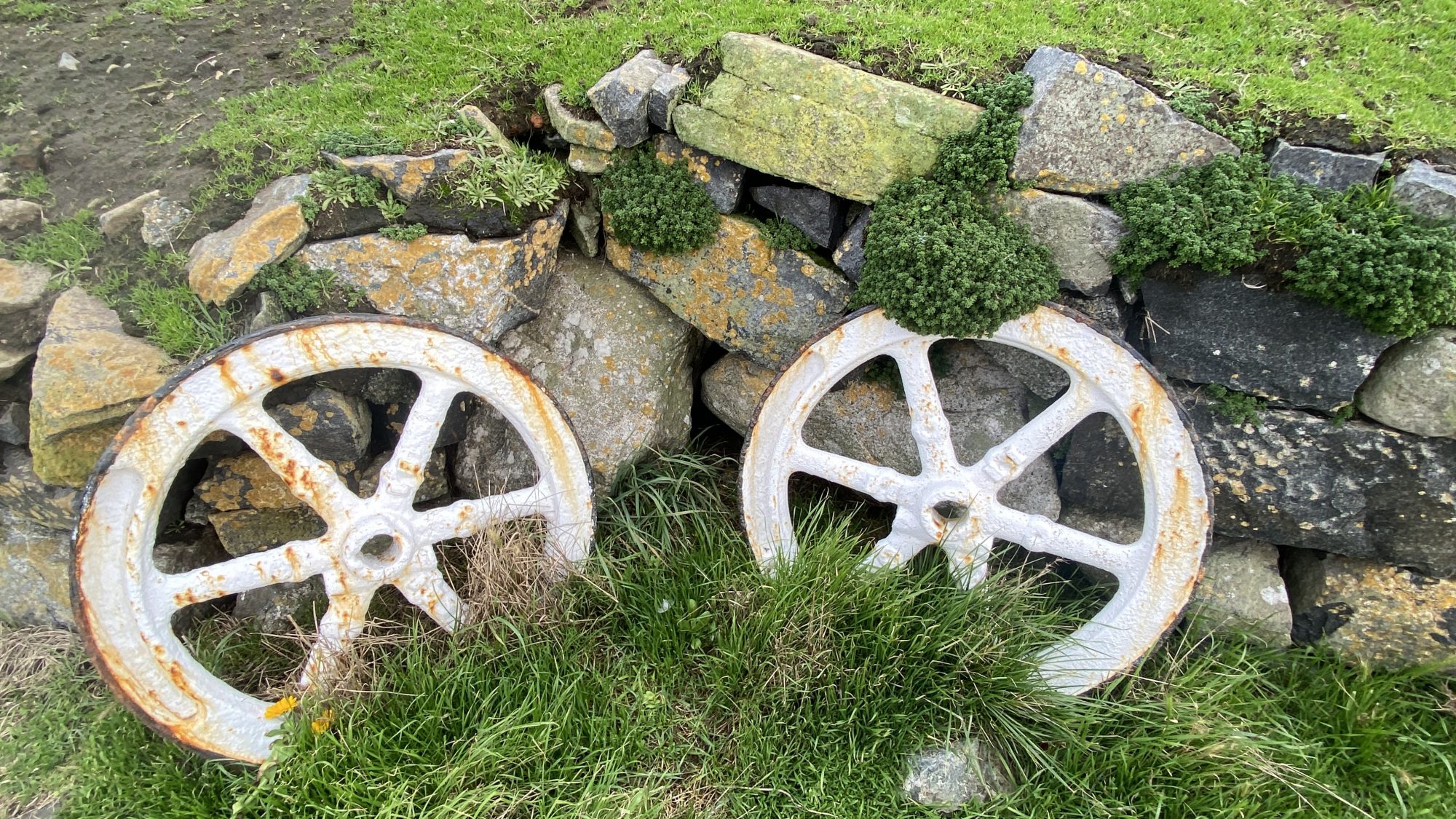 At one time the area under these artifacts was covered with bricks from the original engine room. The bricks are still there but they are now overgrown with grass. Removal of the overburden would improve the appearance of the area.
At one time the area under these artifacts was covered with bricks from the original engine room. The bricks are still there but they are now overgrown with grass. Removal of the overburden would improve the appearance of the area.
50th Anniversary of Ecological Reserves in British Columbia
Often when we visit special ecological areas our observations are restricted to a limited view. In this video, we visited six diverse Ecological Reserves with the goal of revealing some of their special features from a distant viewpoint as well as a close up one. Under a special permit from BC Parks, Jamie Frith used his drone and a macrophotographic camera to enable us to present a unique perspective on the reserves.
This video was made for the Friends of Ecological Reserves with the support of BC Parks. We started the project in March 2021 and originally were only allowed by BC Parks to film in 6 Ecological Reserves in the southern part of Vancouver Island due to restrictions of COVID 19. Plans to include ERs from the interior of the province also were not possible As those restrictions were eased mid summer, we were able to extend our range and travel North to include the Nimpkish River ER, in order to include a representative area of mature Douglas Fir forest.
Ecological Reserves which we were able to include were:
- Nimpkish RIver ER#118 start time- 1:20
- San Juan RIdge ER #83 start time- 5:58
- Oak Bay Islands ER #94 start time-11:02
- Mount Tzuhalem ER#112 start time- 16:38
- San Juan River ER#141 start time- 25:01
- Race Rocks ER#97 start time- 25.03
One of the goals of the Ecological reserves act is to provide protected places for research and education. Some reserves, especially those with seabird colonies are closed to the public and only accessible with a permit from BC Parks. Since it is illegal to fly a drone over any provincial (or federal) protected area without a permit, the use of the drone was possible only with permission and precautions for no disruption to animals. As mentioned in several of the interviews, because of the sensitive ecological nature of the areas, the public is not encouraged to visit Ecological reserves.
THE 50th ANNIVERSARY:
On April 2, 1971, the Government of British Columbia became the first jurisdiction in Canada to pass legislation to protect Ecological Reserves, places set aside primarily for ecological research and education, not recreation. The Ecological Reserve Act led to an Order in Council that established the first 29 ecological reserves on May 4, 1971. Fifty years later, British Columbia has 148 ecological reserves across the entire province. This video features just a few of the ones on Vancouver Island. In 2021, the BC government proclaimed April 2nd as Ecological Reserves Day in commemoration of the 50th anniversary of the passing of the Ecological Reserve Act.”
Protecting rare species and ecosystems is just one of the reasons to have an ER established. Equally important was protecting representative examples of natural ecosystems. See the wording in the Purpose section of the ER Act:
Garry Fletcher
Many Visitors at Race Rocks

Ecological Notes:
Race Rocks is a wealth of biodiversity, and an amazing place to get to spend any amount of time. Despite the huge amount of wildlife that spend time on Race Rocks over the winter, it can feel a little quiet. Not last week!
We were super lucky getting some of the Pearson College students out despite COVID lockdowns on Campus, this is always one of the highlights of our time at Race Rocks! The kids always have the best questions and remind me why I pursued the life I live now. Any opportunity to share the joy and smells of Race Rocks.

Pearson Students getting Elephant Seal 101. Photo by Laura Verhegge
After the final group of students left, we got a surprise visit from DFO via their helicopter coming by for a socially-distanced visit. We had a helicopter buzzing us throughout the week, and it wasn’t until it landed at the end of the week we realized that was most likely the crew checking out the island, seals, and heli-pad. The elephant seals clearly weren’t fans of the helicopter. Interesting-ly the idling helicopter covers the same sound frequencies the Beachmaster uses to drum his dominance. Our Beachmaster tried drumming at the intruder, but he couldn’t overpower the sound and decided that abandoning his harem and a trip into the ocean was preferable to hanging out with a helicopter.
The next day we woke up to a new female Elephant Seal! We suspect this seal was Tyra from last year, going off her scar patterns and BEAUTIFUL eyes. At this point in the season we have expectations for these seals: they come ashore, hang out for 5 days, give birth, nurse for 21 days, mate and leave. Tyra was a reminder that we don’t really know that much about these mysterious animals. She came ashore, mated, and left. She looked great, very plump. I am really quite surprised. Maybe not all pregnancies come to term, and in that light her behaviour actually makes a lot of sense. She needs to come ashore when a Beachmaster is ready to mate, and if she doesn’t have a pup to birth then there really isn’t a reason to stick around and wait until it’s time to moult.

Tyra returning to Race Rocks to visit the Beachmaster. All hail the Beachmaster!
And we had a new pup born! I told you lots happened. Rhi-Rhi has been ashore since January 25th and slipped out a new pup this morning. The new pup is super chirpy, and very mobile; it had a very ‘rolled up’ vibe directly after being born, with curled fingernails and it’s giant flippers wrapped around itself. We expect her to nurse until the 22nd of February, but clearly I need to stop trying to predict what these animals are going to do.

Rhi-Rhi inspecting her newborn pup.
Facility Work:
Race Rocks has a Boston Whaler from it’s Coast Guard era that can be used in case of an emergency. During a very low tide we figured this was the ideal time to re-spool the twisted up cable used to launch the boat. While it’s easy to think that emergencies never happen, it’s great to know that in that hypothetical situation the boat will be able to be launched on any tide without any problems. Big thanks to the previous Eco-Guardians who did some great boat maintenance!
DND events:
Lots of blasting over the last week, some of the Pearson College students were definitely surprised.

Elephant Seals seem happiest when all smushed up against each other.
Feature Event:
We had someone report a wayward Elephant Seals wandering around Sturdees Beach & the Gorge vale Golf Club. This fits very well with the theme of ‘we don’t really know much about Elephant Seals’ and thought it would be worth mentioning. As the Northern Elephant Seal population continues to recover, hopefully we’ll all get to experience more Elephant Seals in British Colombia, and sometimes that might be a returning pup who hasn’t really figured out the timing of things yet. They’re really remarkable animals, who spend a very small proportion of their time (<10%) above the water Over the last 2 years there have been wayward pups reported crawling around in areas where they were not wanted, these little seals are just looking for some place safe to moult and head back into the ocean. This is one of the parts that makes Race Rocks such an important place for these animals: a place on land where the seals can hang out and sleep without being disturbed: their time on land relies on them fasting for weeks on end losing up to 40% of their body weight during these stints. Every time they get woken up or stressed that is another drain on their limited energy available, leading to the first couple of years where mortality can be up to 75%.

A wayward elephant seal pup at Christie Point, photos by Dorothy Chambers
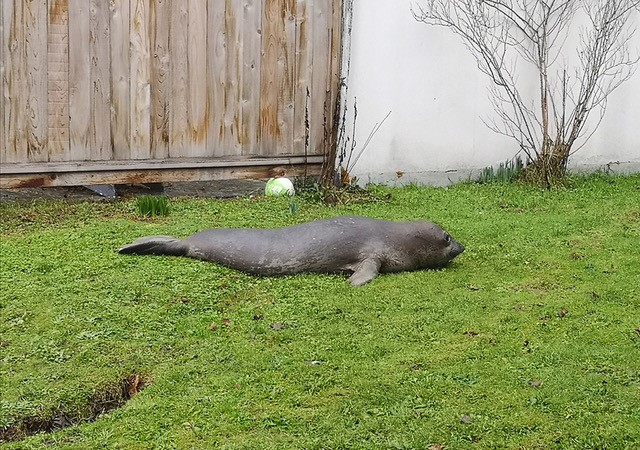
The silver colouration shows this wayward pup has already moulted, so probably from last years birthing season. While we would expect pups to return to Race Rocks to moult, we don’t really know how they return to the same areas, and they may just try out new areas at different times; or just get lost.
https://www.timescolonist.com/local-news/seal-hits-the-links-at-gorge-vale-likely-same-one-that-has-toured-view-royal-5009767
Weather Events:
It was a lovely week of weather, punctuated with a nice little blast of wind of 40 knots+ Sunday and Monday.
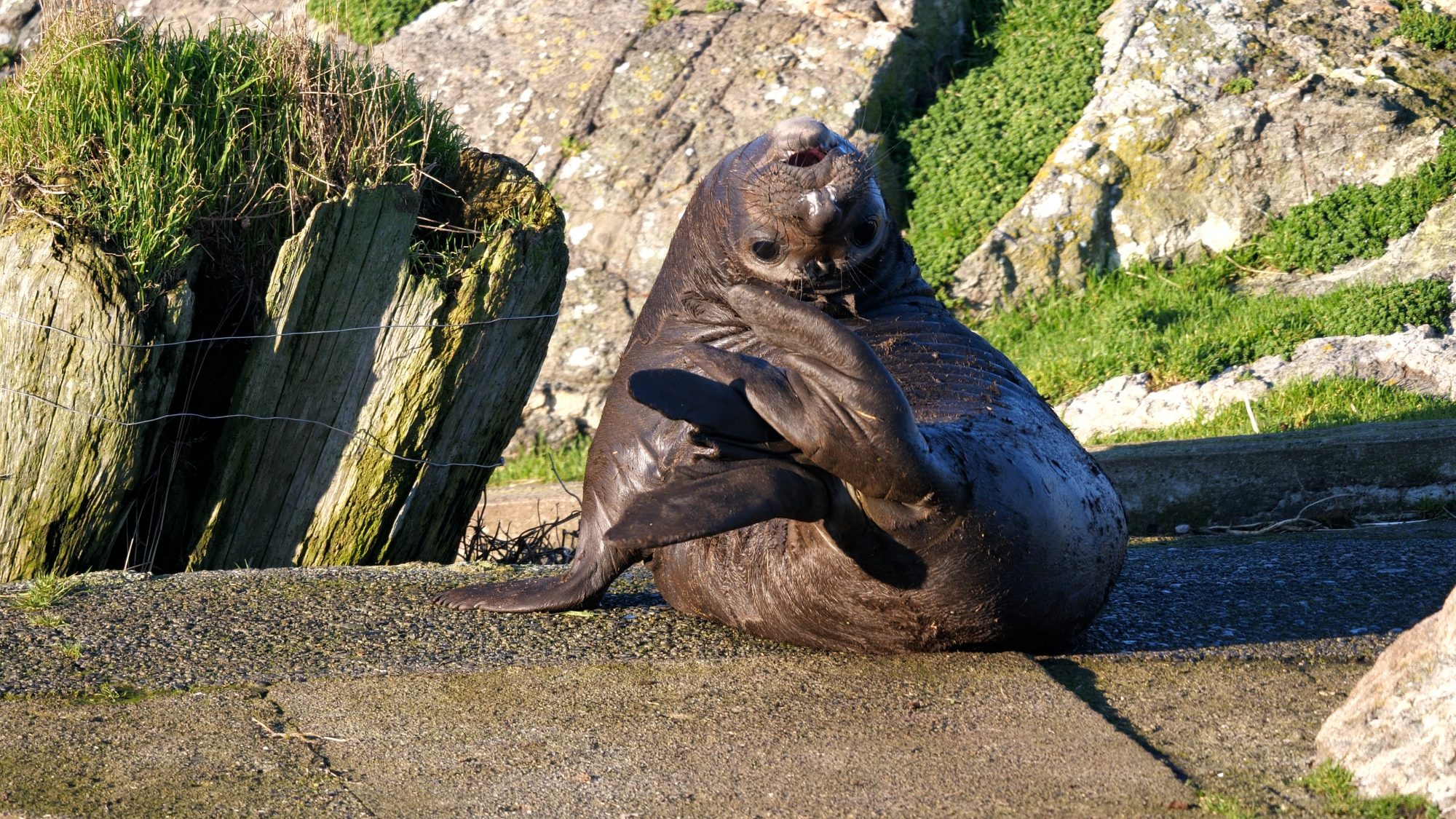
The first pup Mikey is already starting to moult his soft baby fuzz into a silvery sleek diving suit of fur at 41 days old.
Weather – Current:
http://www.victoriaweather.ca/current.php?id=72
Weather – Past:
New Elephant Seal + Pupdate

Rhi=Rhi came back and is ready to birth!
Ecological Notes:
We have a new female Elephant Seal on Race Rocks! While she looks suspiciously like one of the returning mothers, without a tag it is hard to tell. She was thoroughly investigated by our local Beachmaster, and sassed Mikey for getting too close. Mikey seems to have learned his lesson to stay out the Beachmasters way, after a few small bites Mikey is now quite mobile and has learned the paths on the island to avoid further conflict.

Lil Blasty in one of the few moments not blasting squawks.
As for the other Elephant Seal Pup: named Nereo by it’s mothers namesake, but I have been referring to it as ‘Lil Blasty’ due to his extreme volume while ‘chirping’. The current theory is that Elephant Seal moms and pups learn each others vocalizations to identify each other, and regardless of the background noise present, they seem to always vocalize at the same volume.
Jocelyn’s vocalizations come in around 50-70db, where Lil Blasty is clocking in at 100-110db with his vocalizations. For reference: WCB recommends not being exposed to over 85db for prolonged times due to hearing damage. It definitely hurts to be outside when he’s shrieking.

The Beachmaster being grumpy that no one wants to mate with him.
Facility Work:
We bucked up the logs that were snagged over the last week, and got them off the boat/seal ramp. Heavy algae growth over the last 2 weeks so we’re started pressure washing the algae to keep things from getting too slipper.
DND events:
Canada’s Navy has started doing tester laps outside of Esquimalt.

Feature Event:
Mikey has learned to avoid the Beachmaster when he’s on the prowl, and decided to explore off the beaten path to avoid any conflict. We suspected he would fall off the ‘mountain’ climbed today, but displayed some remarkable manoeuvrability for a chubby little seal.

Mikey mountain-climbing.
A hallmark of the maturing pup is the wear-pattern on their chins. The chin is a key instrument for Elephant Seal locomotion: where they re-arrange their belly by lifting it up with their chin. The chin can also work to level the seals bulk up onto rocks, steps, and rough terrain.

Mikey starting to show his all-important chin patch.
Weather Events:

January means the start of some epic sunsets.
The last couple of days the temperature has dropped down to 4°C with light N winds around 10-15knots. This is log weather.
Weather – Current:
http://www.victoriaweather.ca/current.php?id=72
Weather – Past:
http://www.victoriaweather.ca/station.php
Revisiting Intertidal Transect sites at Race Rocks
Watden’s Report, September 3, 2021
I was fortunate to be able to get out to Race Rocks on one of the last morning low tides of the season. I wanted to revisit intertidal locations around the island in order to take photos of belt transects in locations I had recorded with baseline studies back in May of 1995. Photographic transects are valuable records in the event of changes that may happen along coastlines, usually caused by humans and/or by extreme weather events .
Images taken in 1995 can be seen in this index on transects: https://racerocks.ca/ecology/ecological-monitoring/
The belt transect files with images will be linked here when they have been processed :
Peg 6 Peg5: Peg 5a Peg 5b Peg 14a, Peg 14b Peg 115.
I was fortunate to have the assistance of Cedric Torres, the ecoguardian in doing the work on the transects.
At this time of year the island is populated by many young glaucous-winged gulls, some fully fledged and other son various states of maturity. There were also a number of mortalities around the island which is typical for this time of year in a breeding colony. In the following videos a number of behaviours of the chicks are shown .
Harbour seals with pups are hauled out on the southern most reef, note the current was still ebbing in this video.
The California and Stellers sea lions have started coming back in large numbers. typically the Californias outnumber the Stelllers at this time of year.
Beneath the tower, the Californians( barking) are predominant: but there is alos a mix of the growling Stellers.
On the East side cove a large group of Californian Sea lions were hauled out. The ones here were very skittish, any movement near the east end of the house would startle them
.
Other observations : two orcas in Race Passage ( surprizingly with no whale watching boats nearby. The nice weather on Sept 3 brought out many whale watching boats and as usual they approach closer to the north side in front of the docks than necessary and well within the distance for viewing marine mammal colonies. The sea lions on that side are more habituated to the presence of humans and these boats than on other parts of the island, but many still go into an alert stage when the boats pass by.
Only a few pelagic cormorants were seen on the south west tip of the island.
The Calendula escapes from gardens of lightkeepers over 50 years ago still exist along the pathways, although the dry summer has been challenging. I was able to make a new species observation of these green blow flies on the flowers.
This summer with the heat dome experience on Vancouver Island there have been reports of damage to intertidal life. I took these images of high intertidal level barnacles in the arintertidal between peg 14 and 15. which show very little damage from this event,
We checked out Anita’s pool #6 . The intertidal life in the area has been unchanged for decades.
On the west side of the cliff near peg 5 , we took these images on the vertical rock face as records of barnacle distribution:
And near peg 15 we noted these finger limpets in a shaded rock at an extreme high intertidal elevation.
- Note peg 15 in upper part of photo
- Finger Limpets

And a follow-up photo of The ill-fated tidepool #13 which was readjusted in the hurricane of 2006
Elephant Seal Bubbles
This was my first full day at Race Rocks and it started with a fog check at 5 am. One of the volunteers from nearby Rocky Point Bird Observatory was interested in doing a simultaneous comparative seawatch from Beechey Head and Race Rocks to determine if the birds leaving Beechey also passed Race, and if so, how long it took. The weather was clear, and the challenge was on! But there was a glitch. Nothing was passing Race Rocks, as there was a sea full of krill and to the west. I climbed the tower to do my watch, and found about 600 California Gulls already in the reserve picking at the krill near the water’s surface. The few alcids that made it here during the one hour watch (from 6:30-7:30) quickly set down rather than flying through. Most (if not all) of the birds Daniel counted at Beechey Head were not counted here. We’ll try again.

Regurgitated krill
On a more entertaining note, the Elephant Seal went for a stroll today, all the way to the dock. I looked out the window at about 12:30, and there he wasn’t. I ran out to see if he was really gone. Whew! Not yet!

He was working his way to the dock.
And eventually got to the water’s edge where he proceeded to stick his face in the water and blow bubbles. How exciting!! If you’d like to see some videos of this event, click here. (By the way, I am using a 600mm lens and keeping my distance!)
where he proceeded to stick his face in the water and blow bubbles. How exciting!! If you’d like to see some videos of this event, click here. (By the way, I am using a 600mm lens and keeping my distance!)
I was thrilled! I thought it meant that he was on his way and could start eating again. Several wildlife watching vessels came by and were delighted to see him. But apparently, this is a daily sojourn for him. Sure enough, as Greg Dickinson predicted, he returned to his resting spot after his trip to the beach! Looks like he’s not done yet.
Ecological Notes:
1 Humpback Whale

Distant Humpback
1 Elephant Seal
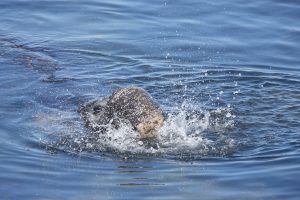
6+ California Sea Lion

15+ Steller Sea Lion

80+ Harbour Seal

1 Feral Pigeon (Rock Pigeon) flew over while I was washing windows
1 Anna’s Hummingbird
2 Killdeer
6 Black Oystercatcher

It’s difficult to hide with a bright orange bill.
25 Black Turnstone
5 Least Sandpiper
18 Common Murre
80 Pigeon Guillemot

4 Rhinoceros Auklet
600 California Gull (feeding on krill at first light)
200 Glaucous-winged Gull
1 Heermann’s Gull
3 Pelagic Cormorant
4 Double-crested Cormorant
Facility Work: Washed all the windows and solar panels
Vessel Traffic: Eco-tourism boats all day, sometimes as many as 3 in the reserve at once. Estimate about 20 vessels. Only saw one private fishing boat in the reserve.

Weather – Current: http://www.victoriaweather.ca/current.php?id=72
Weather – Past: http://www.victoriaweather.ca/station.php?
Elephant Seals From the Remote Control Camera
This year, so far there has been a very successful set of births of Elephant seals at Race Rocks. This is the 13th year that Elephant seals have been breeding and having births in the ecological reserve. Currently three females and four pups along with a large male can be seen from the remote-controlled camera 1 from the top of the tower:
Humpback Whales Feeding off Race Rocks
There has been 2 humpbacks hanging around the Becher Bay – Race Passage for the last couple of weeks. They have always been a little bit distant from the Lighthouse, but on December 30th 2020 they came right up to the SW corner of the lighthouse and did some feeding right at the current line. There’s lots of turbulence, so it could be some bubblenetting or lungefeeding. Really cool to see them use the crazy currents around Race Rocks to get a meal in.



















